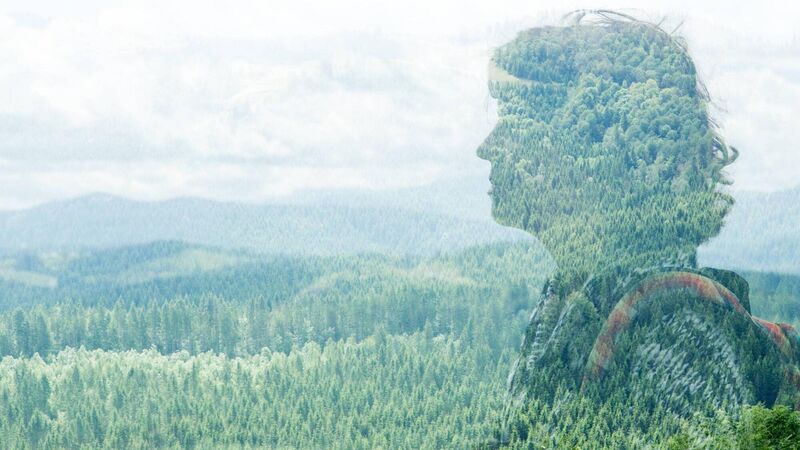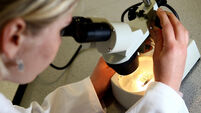IN THE just-released film The Outrun, Saoirse Ronan plays Amy Liptrot, a 30-year-old writer who returns to her remote island home.
There, she reconnects with its wild beauty and slowly rebuilds her mental health after a decade of caning it in London. In her 2016 memoir of the same title, Liptrot writes how nature — sharp, cold, wild Scottish nature — helped solidify her sobriety following an increasingly catastrophic alcohol addiction.
She’d returned to Scotland after completing non-residential treatment in London: “I was worried my life was over and I’d never have fun again.”

From Orkney to Hackney back to Orkney, Liptrot’s life was filled with extremes. Growing up on a remote sheep farm on the northern Scottish archipelago closer to Bergen than London, battered by wind and sea, with a father frequently hospitalised for bipolar disorder and a mother who turned to evangelical Christianity to cope, Liptrot escaped south to the hedonism of London’s parties and pubs.
“Years went by in a blur of waiting for the weekend…or for the hangover to end,” she writes. After losing friends, relationships, jobs and flats, she moved back to Orkney, newly sober. She swam in icy water surrounded by curious North Sea seals, walked on deserted beaches, and immersed herself in the stark beauty of the islands.
“Lately, I’ve noticed a gradual reprogramming,” she writes. “In the past, when I was under stress, my first impulse was to drink….now, I’m not just fighting against these urges but have developed new ones…my first thought was sometimes not a pint, but ‘get in the sea’.” By immersing herself in nature, she slowly rewired her neural pathways.
In her book By The Sea: The Therapeutic Benefits of Being In, On and By The Sea, marine biologist Dr Deborah Cracknell refers to the Biophilia Hypothesis, an idea popularised in 1984 by US biologist Edward O Wilson. (The term biophilia, meaning ‘love of life / living systems’, was first used by psychoanalyst Erich Fromm in 1964).
Wilson’s hypothesis proposes that the reason we love nature so much is evolutionary – that after millions of years of being part of a greater eco- system, we are genetically hardwired to respond positively to aspects of the natural world that support our survival (and react negatively to the bits that don’t, which would explain being scared of spiders, snakes, etc). Our emotional connection to other living beings is, therefore, not just individual preference but a basic human need.
Cold water therapy
Victorian doctors prescribed dips in the sea and trips to spa waters as medicine. More recently, an extreme example of blue therapy is Wim Hof, aka The Ice Man — when his wife killed herself in 1995, he famously used cold water immersion to help himself recover from grief, shock and depression. In 12 Step recovery, atheists use the acronym GOD to mean Great Out Doors, getting hooked on nature in the manner of Amy Liptrot, although perhaps not on faraway uninhabited islands. In lockdown, even the most cold-phobic among us got in the sea to stay sane.
Blue and green therapy, as time spent in nature has been rebranded, is nothing new — it’s only our rupture from nature that is new(ish), so we are now hearing the scientific proof of what our inner selves have always known. That time spent in nature is healing, soothing, uplifting, and regenerative, giving us the headspace to think creatively.
For me, walking in nature – in wide open heathlands, in woods, through fields – is the ultimate head-clearer and thought-processor, while if I want a factory reset, I jump in the sea, especially when it’s freezing. They don’t call it swimmer’s high for nothing.
From the creative work of Wordsworth to Nietzsche, the Brontes to Van Gogh, and Frida Kahlo to Georgia O’Keeffe, there are endless examples of how the psyche is profoundly linked to and dependent upon the natural world.
It can even make a difference for people in hospital beds. In 1984, pioneering behavioural scientist Dr Roger S Ulrich showed how patients with a view of nature recovered faster and were discharged sooner.
A Japanese study showed how even placing a vase of roses on the desks of office workers made them feel calmer after four minutes. Also, a research review published in Science Advances, Dr Gregory Bratman, from the University of Washington, and his colleagues found that contact with nature was associated with, among other positive responses, greater happiness, positive social interactions, a sense of purpose, and a decrease in mental distress.
Inspired by Dr Ulrich’s 1984 findings, Kathy Willis, professor of biodiversity at Oxford, writes in her book Good Nature how spending time among trees and open spaces calms and soothes. Even within 90 seconds, the scent of conifers — molecules called pinenes — reduces human heart rate, while the scent of juniper and cypress trees boosts human immunity. The Japanese practice of Shinrin Yoku, or forest bathing, is a mainstay of Japanese culture and is growing in popularity in the West.

Green deal
Dr Sean Owens has a 400-year-old elm tree outside his surgery, which he encourages patients to sit under. Owens belongs to Irish Doctors For The Environment, a group that seeks to affect cultural change in our relationship with nature. He also belongs to Plant-Based Doctors Ireland, which advocates for the benefits of plant-based nutrition, and the Irish Society of Lifestyle Medicine, which is again about nature, nutrition, exercise, and natural destressing rather than prescription pills.
With so much hard evidence about the restorative powers of nature on human health, you’d wonder why this approach isn’t a reality. Why aren’t more health professionals advocating it?
“Green prescribing isn’t yet well defined because the idea of prescribing connection to nature as a therapeutic agent is still relatively new,” says Owens. He explains that green prescribing differs from your doctor suggesting going for a walk sometimes as it’s more structured. It takes the idea of a prescription — a fixed dose, a fixed duration, a calculable outcome — and applies it to nature. So it could be a 12-week course that involves a regular long walk, forest bathing, or a park run. Then, the impact on blood pressure, stress responses, etc, are measured in the same way the effect of pharmaceutical intervention would be measured.
“Green prescribing is more robust than signposting,” says Owens. He describes how follow-up studies from the 12-week Woodlands for Health initiative run by Coillte and Mental Health Ireland, which involves a weekly forest walk and a cup of tea afterwards, “showed enormous therapeutic benefits” for participants. “Our relationship with nature is not new. What’s new is our separateness from it.”
As a health resource, nature is free and therefore not for profit, so there is little commercial incentive to fund the infrastructure needed to create access for everyone, not just those who have private transport or live in places with easy access to nature. There’s more money in pills, as well as a cultural expectation around what doctors prescribe: “We’re expected to prescribe pills. Yet nature is such a powerful untapped resource for mental health,” says Owens.
However, high-pressure modern medicine is not set up for this approach. “Busy doctors, surgeries, and hospital wards are not the best places to prescribe nature,” says Owens. “Also, pharma companies have a huge influence on medical training. Who would fund a [nature] trial? There’s no incentive.”
He emphasises that prevention is much better than cure and how more green prescribing “would have a huge effect overall on the health service — all the wins are upstream, the benefits not just for health but for civil society as a whole.”
Happier, calmer, healthier people are more connected to themselves and their environment —which might sound utopian, but it’s all right on our doorstep.
For this cultural shift to happen, there needs to be funding, equal access to green spaces (so that it’s not just the middle classes going sea swimming or nature walking), plus infrastructure and transport. “To rely on doctors to prescribe nature is missing the point,” he says. “Ireland needs to reframe nature as a health opportunity.”
Further reading
- Biophilia by Edward O Wilson
- To The River by Olivia Laing
- Some Of Us Just Fall by Polly Atkin
- H is For Hawk by Helen McDonald
- Nature Cure by Richard Mabey
- Losing Eden: Why Our Minds Need The Wild by Lucy Jones
- The Salt Path by Raynor Winn


CONNECT WITH US TODAY
Be the first to know the latest news and updates











